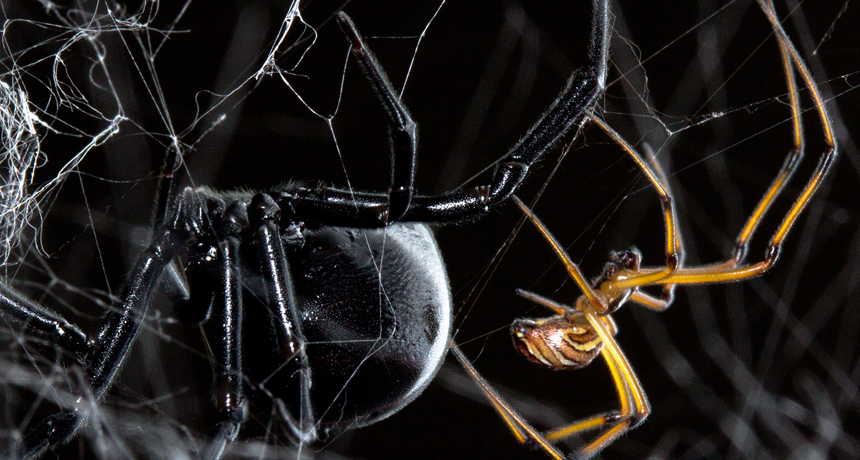Animals were the original twerkers

A male black widow spider (right) shakes its rear to alert a female to its presence.
Sean McCann/Simon Fraser Univ.
- More than 2 years ago
Twerking is so 50 million years ago.
In fact, it’s probably much older than that. Today, the provocative, butt-shaking dance move is enough of a social phenomenon to merit a word in the dictionary (with twerking defined about as tastefully as possible here by actor Morgan Freeman), but animals have been shaking their hindquarters for ages, for a variety of purposes (more on that below).
Black widow spiders are the latest documented twerkers. In their case, it’s the males that shake their rears. Black widow females are aggressive predators and will immediately kill any prey detected in their webs. This presents a problem for males approaching a female to mate; in this case a literal misstep means becoming the female’s dinner.
To figure out how the males avoid being eaten (at least before mating), researchers at Simon Fraser University in Canada measured vibrations created by males and by prey in webs of western black widows (Latrodectus hesperus). They compared the vibrations, and the females’ responses, to those of the hobo spider (Tegenaria agrestis), a species in which females rarely attack courting males. To capture the details of small vibrations, they used a fun tool called a laser Doppler vibrometer, which measures small changes in a laser beam aimed at a surface.
Sure enough, black widow males appeared to have a death-avoidance strategy. They produced vibrations different from thrashing prey by means of “lengthy andrepeated bouts of abdominal tremulations” averaging 43 wiggles per second, the researchers report January 17 in Frontiers in Zoology. You can see a male’s moves in this video:
Credit: Samantha Vibert
These minor tremors were less likely to trigger females’ predatory response than were the struggles of prey caught in the web. Male hobo spiders, on the other hand, don’t face a threat from females and didn’t vary their movements much from those of prey.
Black widow spiders are just one species in a long line of animals that put their rears in gear. Here are a few fantastic uses of rear ends across the animal kingdom, for reasons both sexual and nonsexual, complete with video links:
Peacock spiders: Flashdance
In one of the most beautiful displays of rump-shaking in the animal kingdom, peacock spiders raise and shake a colorful flap on their abdomens as part of an elaborate mating dance. If you haven’t seen it, you must, and if you’ve witnessed it before you’ll want to see it again.
Peacocks: Infrasonic shake
Technically, a peacock’s big fancy train is not its tail but on its back. The actual tail feathers are behind the display. After spreading its train, a male shakes the long feathers in either a “shiver” (from center feathers to outside feathers) or “pulse” (emanating from the base of all the train feathers). Scientists have found that the shaking creates infrasound below 20 hertz that are too low-pitched for humans to hear (we just hear rustling) but that peahens respond to.
The twelve-wired bird of paradise: Shake it slow
I like this guy’s style. As part of a mating display, he swishes his yellow tail side to side, flicking thin wiry feather tips in front of the female’s face. Birds of paradise have evolved an astounding variety of dances, and while the dancing behavior is passed on genetically, young males watch older males and practice their moves alone to perfect them.
Wire-tailed manakin: Shake it fast
Males gather in groups, or leks, and stage dance-offs for females’ attention. The wire-tailed manakin’s dance involves flicking his tail feathers rapidly back and forth, often in a female’s face.
Cats: Wiggle and pounce
It’s cute when housecats wiggle their rear before pouncing, but big cats do it too. They are probably digging in their back feet and getting in a good position to launch from their powerful back legs.
Honeybees: Follow the butt
Honeybees may go back as far as 100 million years, and they’re famous for their butt-shaking waggle dance. A bee that has found nectar or other goodies returns to the nest and dances in a figure-eight pattern, shaking its abdomen down the center path with the duration of shaking indicating distance to the food source and the angle of the path relative to the top of the hive indicating direction.
Japanese cockroaches: Defensive moves
The invasive species turned up in New York City recently, as I wrote earlier this month. The roaches are more cold-tolerant than U.S. house roaches, but more unusual: They produce a viscous secretion that they fling onto predators by — you guessed it — shaking their butts.






